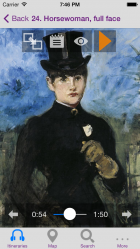
Caravaggio created a new style of painting, called Tenebrism, in which pictures consisted of a black background and harshly lit figures, highlighted with strong contrasts of light and shade. The style was to have a great influence on early 17th century Baroque painting.
This St. Catherine is an example of the Tenebrist style. The light reflects the great bladed wheel that was the instrument of this beautiful and highly intelligent Eastern princess’s martyrdom. She astonished the court of judges that tried her, which is why she became the patron saint of philosophers. The bladed wheel miraculously fell onto her executioners, so the saint was beheaded with the sword she is seen holding in her beautiful hands in this picture. The palm leaf of martyrdom can be seen at the bottom of the painting.
Although the identity of the sitter is unknown, it has been thought that it might be the portrait of a courtesan who was acquainted with the painter.
The artist led a very troubled life, and was even involved in a murder. He was pursued by the law and had to live among beggars, some of whom he painted in his works. He made them look so real that they clashed with the idealized style used for religious themes, and this led him to have problems with the Church.
(c) (R) 2013, MUSMon com S.L.
Text (a) Catalina Serrano Romero
Picture
Source: Wikimedia Commons
Author: Ismoon
Permission: The work of art depicted in this image and the reproduction thereof are in the public domain worldwide. The reproduction is part of a collection of reproductions compiled by The Yorck Project. The compilation copyright is held by Zenodot Verlagsgesellschaft mbH and licensed under the GNU Free Documentation License
Independently produced by MUSMon.com, the audio guide for the Thyssen-Bornemisza Museum offers you a wide-ranging, light-hearted and educational tour of one of Spain’s most outstanding art museums. It contains 90 minutes of commentary, illustrated with over 52 high-quality images, so you won’t miss a single detail during your visit.
We will guide you on your journey through the history of painting. +info




































































